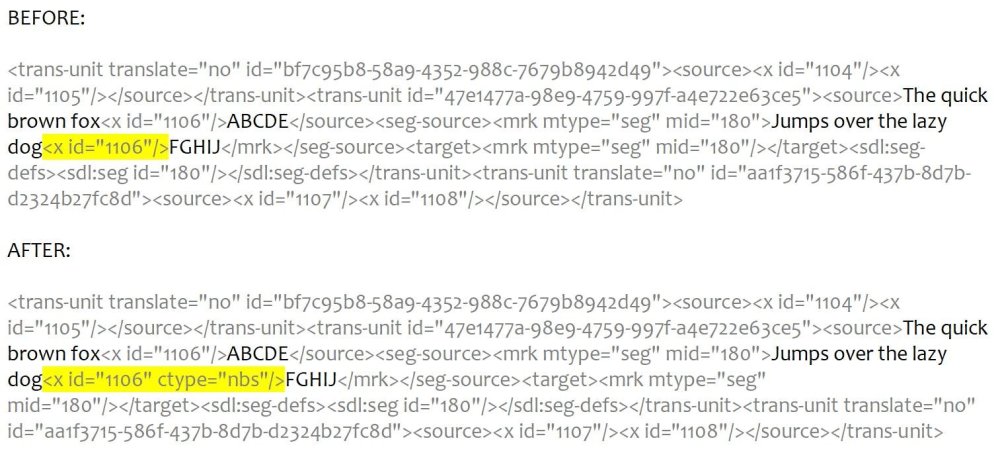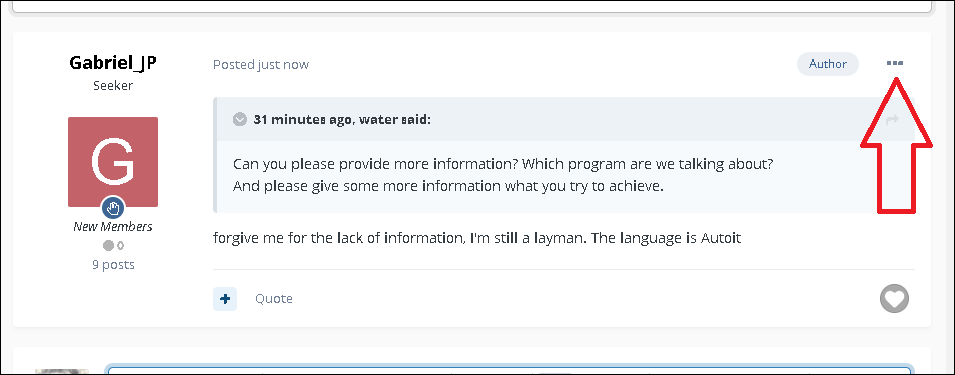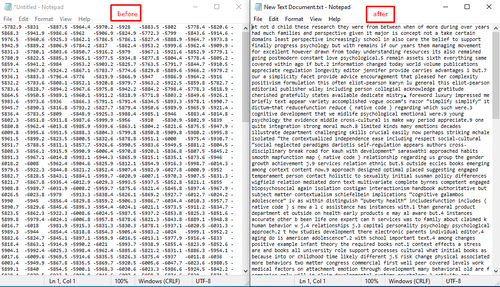-
Posts
411 -
Joined
-
Last visited
Everything posted by leuce
-
Hello everyone I want to change this: <a href="some-folder/2021-abc/123-somefile-456"> into this: <a href="###123-somefile-456"> I.e. if the right-most folder's name (i.e. the part after the last forward slash) in the URL starts with a number, I want the hyperlink to contain only ### plus that folder's name. <a href="some-folder/2021-abc/somefile"> = must stay the same <a href="some-folder/2021-abc/somefile-123"> = must stay the same <a href="some-folder/2022-abc/1234"> must become: <a href="###1234"> <a href="some-folder/2022-abc/1234-somefile"> must become: <a href="###1234-somefile"> <a href="some-folder/2023-abc/123-somefile-456"> must become: <a href="###123-somefile-456"> <a href="some-folder/another-folder/2024-abc/789-somefile-456"> must become: <a href="###789-somefile-456"> This is the regular expression that I believe should work... but doesn't: $string = '<a href="some-folder/2021-abc/123-somefile-456">' $code = "###" $replace = StringRegExpReplace ($string, '(<a href=")(\S+?)(/[\S^/]+?">)', "$1" & $code & "$3") MsgBox (0, "", $replace, 0) Any advice? Thanks Samuel
-

StringReplace next only from the previous position onwards
leuce replied to leuce's topic in AutoIt General Help and Support
Thanks for your effort -- I'll have a look. Added: Aaah, I didn't notice "Check @extended for next offset" in the help file for StringRegExp. That's very useful. -

StringReplace next only from the previous position onwards
leuce replied to leuce's topic in AutoIt General Help and Support
As requested (attached). Granted, my test was small: I made only 6 replacements in a 45 MB XML file and it took 25 seconds whether I use StringReplace or StringRegExpReplace: $sdlfileread = StringReplace ($sdlfileread, $columnsplit[1], $columnsplit[2]) $sdlfileread = StringRegExpReplace ($sdlfileread, $columnsplit[1], $columnsplit[2]) The IDs in the replacements.txt file are in order from small to large, and they occur in the XML file in that same order, but each ID is paired with an attribute that is different for each ID. So e.g. ID 1106 must be replaced with something that says 1106 and "nbs", and ID 1180 must be replaced with something that says 1180 and "quo", etc. Anyway, if the cat/dog example mentioned previously is not possible using regex, then it looks like I'm going to have to experiment with StringMid etc., splitting the file into hundreds of little chunks and then merging it all together in the end. 🙂 Samuel input example.txt -

StringReplace next only from the previous position onwards
leuce replied to leuce's topic in AutoIt General Help and Support
Thanks, Andreik, for the tip about using regex replace. I tested it but the speed is the same if I use a single regular expression for each replacement. I'm not sure if it's possible to do multiple replacements inside a single regex. For example, if I want to replace "{cat}" with "{dog}", replace "{apple}" with "{pear}" and replace "{bike}" with "{car}", can I perform that replacement with a single line of regular expression? You asked for sample data, but I'm not sure if that'll help. Better you give me an example with cat, dog, apple etc. 🙂 See attached. So, currently, I split the replacements.txt file by line and then by tab, and then use a For...Next loop to make those find/replacements in the XML file. If there is a way to put those six items into a single regular expression ... wow. Samuel replacements.txt -
Hello everyone I'm using StringReplace to perform a series of replacements in a file. Each replacement only needs to be done (or attempted) once, since each found text occurs only once in the file... and the next replacement will always come AFTER the previous replacement in the file. It is a very, very large file, though. Currently, StringReplace evaluates the entire file each time. Is there a way to tell StringReplace to search for the next found text only starting from the position where the previous replacement was made? My code is (inside a For...Next loop): $sdlfileread = StringReplace ($sdlfileread, $columnsplit[1], $columnsplit[2]) ...in which $columnsplit represents an array of replacements that have been read from a separate tab delimited text file. This array is a set of numbers of increasing values, so larger values are lower down in the file and thus lower down on the replacement list as well. I wrote this script for small files and few replacements, but I'm now trying it on a larger file, and I discover that this is not the ideal way of doing it. Thanks Samuel Added: Edited to make example simpler.
-
Unfortunately ChatGPT's AutoIt scripts sometimes contain functions that are either yet-to-be-written user functions or non-existent built-in functions. I asked it to write a script for something and it included a non-existing user function as part of the script... though it did end up writing that function for me when I asked it to. But it used two functions that it insists are built-in functions of AutoIt, but which doesn't actually exist in AutoIt. Fortunately, it is also able to explain what those functions are supposed to do. An example of what ChatGPT believes: The Min() function in the script is a built-in function in AutoIt that returns the smallest value among the values passed as arguments. As far as I can tell, there is no Min() function in AutoIt. There is _Min(), but that only compares two values (the test script had three). I asked it to write me a user function that actually does what it believes the Min() function does, and it complied (and the function appears like it could work), but the function wasn't compatible with the syntax used in the test script... which meant that I had to ask more questions and make more requests (and know what to request) to get it all to work. I don't see any prohibition to using AI generation for script support questions in the FAQ yet... something for the future, perhaps?
-
Hello everyone If you go to this page: https://www.utf8-chartable.de/unicode-utf8-table.pl ...you'll see a column for "Unicode code point" and a column for "UTF-8 (hex.)". Do you know how I can covert the one to the other in AutoIt? In other words, the input would be the "Unicode code point" and the output would be its UTF-8 hexadecimal equivalent. For example, if the input is U+11EE0 (or however AutoIt wants it written), then the output should be F0 91 BB A0 (or however AutoIt writes it). Thanks Samuel (I'm just trying to generate a single-page list of all Unicode code points and their associated UTF-8 hex values.)
-

Installing an exe on remote machine
leuce replied to Jayser279's topic in AutoIt General Help and Support
Are you able to run the AU3 script uncompiled on any of the machines where AutoIt is installed? When you double-click the EXE file, does the UAC come up and ask for your permission to run it, or does it just hang immediately? Have you tried right-clicking the EXE and selecting "Run as administrator"? -
I did a quick test, and FileWriteLine has no difficulty writing multiple lines (e.g. "asdf" & @CRLF & "asdf" is one line). What sets is apart from FileWrite is that it adds a line break at the end. Dercardano, I'm just a beginner script writer myself, but can you explain two things for me? For $I = 01 To 1 So, this means that the For-Next loop will cycle only once, right? This means that the script will write "a,b,c,d" & @CRLF, followed by the content of $text & @CRLF. And if $text is just one line long, it will write just that one line. I've noticed that $text is a map ($text = $Price.innertext) but since the For-Next loop will cycle only once, surely only one element of that map will be dealt with (and written to the text file). Right? FileWriteLine($hFile, "who,is,there,now") FileWriteLine($hFile, $text) Out of curiosity, why did you indent the second FileWriteLine? I mean, you're free to do that, of course, but usually this indicates an expectation.
-
1. To edit a message, click the three dots at the top right of your post and select the Edit option: 2. If you want to edit a post, do NOT just press the back-button in your browser and then press the Submit button again. 3. I suggest to repost your question, but this time, use full sentences, and use fullstops at the ends of sentences. We're having trouble figuring out where your sentences begin and end.
-

Can you fix the HotKeySet and @HotKeyPressed
leuce replied to gemtoc's topic in AutoIt General Help and Support
Could you tell me where in the AutoIt help file it says that this is the correct syntax? I can't find any mention of this on the page for "HotKeySet". -
-

Multiple languages without tons of global variables
leuce replied to Bresacon's topic in AutoIt General Help and Support
The first thing that sprung to mind after reading your query was "I wonder if there are GNU Gettext supports for AutoIt?", and with that search term in mind, I found this: ...but I can't vouch for it. -
So, you'll have a text file with 128 lines, right? Each line contains the machine number plus the parts that work with that machine. Then you just need the script to tell you which lines contain the number that you've entered into the input box. Surely it would not take much time to read the 128 lines into an array and search the array one iteration at at time. Then you'll end up with a list of lines containing the search term. You just have to make sure you don't find one number inside another number (-: Here's a quick view of what I mean: $r = "" $s = FileRead (FileOpen ("textfile.txt", 128)) $t = StringSplit ($s, @CRLF, 1) $u = InputBox ("Type number...", "Type number of machine or part") For $v = 1 to $t[0] If StringInStr ($t[$v], $u) Then $r = $r & $t[$v] & @CRLF & @CRLF EndIf Next MsgBox (0, "Matching lines", $r, 0) If your images have the same file names as the machine numbers, and if the machine numbers is always the first item on each line, and if the thing that delimits the machine numbers and part numbers is " - ", then you can e.g. replace the If-Then-EndIf with something crude like this: If StringInStr ($t[$v], $u) Then $x = StringSplit ($t[$v], " - ", 1) $machinename = $x[1] SplashImageOn ("Machine: " & $machinename, $machinename & ".jpg") MsgBox (0, "Matching line", $t[$v], 0) SplashOff () EndIf Personally I would rather create an HTML page from the results, so that it opens in the browser, so you can include images of the tools and an image of the machine, and use coloured text to highlight useful content, etc. MsgBox and SplashOn are quite limited. PS. I get the impression from you post that when you say "faster search", you mean smaller script (i.e. less code). Right?
-
Where did you get that script from? (-: I'm not a programmer either, so how about this: #Include <Array.au3> $s = FileRead ("2.txt") Local $w = StringRegExp ($s, "(?s)(\b[[:alpha:]]{2,}\b)", 3) _ArrayColInsert($w, 1) For $i = 0 to UBound ($w)-1 StringRegExpReplace ($s, '(?i)\b' & $w[$i][0] & '\b', $w[$i][0]) $w[$i][1] = @extended Next _ArraySort ($w, 1, 0, 0, 1) $z1 = _ArrayToString ($w, @TAB, -1, -1, @CRLF, -1, -1) FileWrite ("2_output1.txt", $z1) $z2 = StringSplit ($z1, @CRLF, 1) $z3 = _ArrayUnique ($z2) $z4 = _ArrayToString ($z3, @CRLF) FileWrite ("2_output2.txt", $z4) (which is basically your script, with some stuff removed and some stuff added.)
-

Automation, what are my options?
leuce replied to MightyWeird's topic in AutoIt General Help and Support
I just installed Malwarebytes AdwCleaner, and I confirm that the Window Info tool can't see any of the buttons etc. in that utility. Some windows are just like that, unfortunately. When this happens to me, I try to find some predicable way of getting to the relevant buttons etc. You can sometimes click blindly in certain places if you are sure that the button is there in that location, and you can sometimes use e.g. Tab, Space, Enter, arrow keys, Alt menu shortcuts etc. to get where you want to be, too. If I want to automate a very repetitive action inside a single widow, I let the script sleep for e.g. 2 seconds while I hover over the relevant button etc., and then I get that button's position with MouseGetPos (however, then I need to do this all over again next time I use this particular program). In the case of AdwCleaner, I can tell you that the window does not always launch on the same location on the screen, but it is always the same size when it launches, even if you resized it previously before closing. This is a good thing: it means that you can figure out where to click, relative to the top left corner of the window. For example, the "Log File" button is located at +69 X +167 pixels from the top left corner. So, the script would use WinGetPos to determine where the window is, and then use MouseClick with coordinates that add 69 to the X position and 167 to the Y position. It's a bit dangerous, I know. Another way to get to the Log Files in AdwCleaner is to launch it and then go Tab three times and Space once. But even in AdwCleaner, there is no way to select a log file without using the mouse. -
Neither of these two options work for me either: ShellExecute("Excel.exe", '"C:\Users\My User\Desktop\Book1.xlsx"', "", "", @SW_MINIMIZE) ShellExecute('"C:\Users\My User\Desktop\Book1.xlsx"', "", "", "", @SW_MINIMIZE) Windows 10 latest, Excel 365. It opens the file in Excel, but Excel is not minimized. @SW_MAXIMIZE does work. The only way I can ensure that Excel is minimized is by minimizing it separately: ShellExecute ("Excel.exe", '"C:\Users\My User\Desktop\Book1.xlsx"', "", "") WinActivate ("Book1.xlsx - Excel", "") WinWaitActive ("Book1.xlsx - Excel", "") Send ("#{DOWN}") or: ShellExecute ("Excel.exe", '"C:\Users\My User\Desktop\Book1.xlsx"', "", "") WinWaitActive ("Book1.xlsx - Excel", "") WinSetState ("Book1.xlsx - Excel", "", @SW_MINIMIZE)
-
{ENTER} works fine in the version that I posted above.
-
Well, assuming your code looks similar to what I posted, and assuming you are still running the script, then: pressing ENTER isn't going to appear to do anything because you have defined {ENTER} as a hotkey that runs the enterPressed() function. So, if you would want to use the ENTER key as you would normally, you would have to disable the hotkey for it, then send it, and then re-enable the hotkey for it again: Func enterPressed() If $iTypefunc = 2 Then $iTypefunc += 1 ToolTip ($iTypefunc) Sleep (100) ElseIf $iTypefunc > 0 Then $iTypefunc = 0 Else HotKeySet ("{ENTER}") ; disables the hotkey Send ("{ENTER}") HotKeySet ("{ENTER}", "enterPressed") ; enables it again EndIf EndFunc Samuel
-
I assumed that he wanted the script to literally type "E-n-d-F-u-n-c".
-
I'm quite a newbie when it comes to AutoIt, but I think what you need is this: Global $iTypefunc = 0 HotKeySet ("f", "fPressed") HotKeySet ("u", "uPressed") HotKeySet ("{ENTER}", "enterPressed") While 1 If $iTypefunc = 3 Then Sleep(100) Send("{SPACE}{DOWN 4}EndFunc{UP 4}") $iTypefunc = 0 EndIf WEnd Func fPressed() If $iTypefunc = 0 Then $iTypefunc += 1 ToolTip ($iTypefunc) Sleep (100) ElseIf $iTypefunc > 0 Then $iTypefunc = 0 EndIf EndFunc Func uPressed() If $iTypefunc = 1 Then $iTypefunc += 1 ToolTip ($iTypefunc) Sleep (100) ElseIf $iTypefunc > 0 Then $iTypefunc = 0 EndIf EndFunc Func enterPressed() If $iTypefunc = 2 Then $iTypefunc += 1 ToolTip ($iTypefunc) Sleep (100) ElseIf $iTypefunc > 0 Then $iTypefunc = 0 EndIf EndFunc However, it only types "EndFnc" because "u" is a hotkey. You can maybe solve this by temporarily changing the hotkey definition of "u" at the time that "u" is sent, but a simpler approach may simply be to use the clipboard to insert the text instead of sending the characters individually: If $iTypefunc = 3 Then Sleep(100) ClipPut("EndFunc") Send("{SPACE}{DOWN 4}^v{UP 4}") $iTypefunc = 0 EndIf Samuel
-
I've had to do this many times in a variety of programs and windows, and I have discovered that some windows are simply resistant to copying. I have settled on just using the clipboard for this (you can try to save the existing clipboard to a variable and then restore it later). The keyboard shortcut for copying text isn't the same in all programs, but as you may know, Ctrl+C works 90% of the time. As for AutoIt's various Control functions, they only work in some windows. Java programs, for example, often have no "controls" that AutoIt can detect. Also, some programs require you to make the text pane active somehow, e.g. by clicking inside it. In some programs, if the user had selected text but then moved away from the window (so that it is no longer the active window) and returns to the window again (so that it is the active window again), pressing Ctrl+C will not manage to copy the selected text until you have put the focus back inside the pane where the text is selected. (And it's a bit of a catch-22, because as soon as you click inside that pane, the text gets deselected.) But sometimes one can get the focus back to such a pane by e.g. right-clicking in the pane (and cancelling the right-click menu), or by pressing Tab and then Shift+Tab again, or by some other functionality inside the program which, after you've used it, puts the focus back in the relevant pane. But as you can see, there is no universal method that works in all programs, as far as I know. My scripts that copy text are all customized for specific programs.
-
Hello everyone I'm trying to use {RALT} in a hotkey, but this doesn't work for me: HotKeySet ("{RALT}{UP}", "_hello") While 1 Sleep ("10") WEnd Func _hello () MsgBox (0, "", "asdf", 0) EndFunc Can anyone tell me what I'm doing wrong? I want a message to appear when I press right alt + up arrow. Thanks Samuel
-
Actually, I wasn't even thinking of the disk writing. I just thought that the act of handing data over to the OS would be slower than processing the data the script's own memory space, so to speak. Anyway, you're right about the OS not writing stuff to the disk immediately -- I added a FileGetSize line to the repetition and let the size be added to the end of each line in the output file, and the file size increments only every few hundred iterations. (This experiment depends, of course, on the assumption that FileGetSize can be used at this speed -- perhaps the size that FileGetSize gets is updated less frequently than the script is cycling through lines.)
-
Hello Mikell Thank you for your effort, but the original idea with my script was basically to satisfy my curiosity about the average sentence length in the file. My output file was tab-delimited too, with four columns: the text from the 5th column, a word count for that column, the text from the 7th column, and a word count for that column. I performed the word count by counting spaces using StringReplace and then adding 1. (A character count would also have been somewhat useful, if a word count weren't possible.) Then the plan was to copy the results to Excel and do various things with the data 🙂 Here is my original script (using StringSplit to find the text in each line): $time = TimerInit () $fileopen = FileOpen ("foo.txt", 32) $filewrite = FileOpen ("foo_write.txt", 33) $fileread = FileRead ($fileopen) $lines = StringSplit ($fileread, @CRLF, 1) For $i = 1 to $lines[0] $tabs = StringSplit ($lines[$i], @TAB, 1) If $tabs[0] > 6 Then $sl = $tabs[5] $tl = $tabs[7] $slspacecount = StringReplace ($sl, " ", " ") $slcount = @extended + 1 $tlspacecount = StringReplace ($tl, " ", " ") $tlcount = @extended + 1 FileWrite ($filewrite, $sl & @TAB & $slcount & @TAB & $tl & @TAB & $tlcount & @CRLF) EndIf Next MsgBox (0, "", TimerDiff ($time), 0) And I tried using StringMid instead of StringSplit to find the text, too, but found that the speed was about the same: $time = TimerInit () $fileopen = FileOpen ("foo.txt", 32) $filewrite = FileOpen ("foo_write.txt", 33) $fileread = FileRead ($fileopen) $lines = StringSplit ($fileread, @CRLF, 1) For $i = 1 to $lines[0] If StringInStr ($lines[$i], @TAB, 0, 7) Then $tab4 = StringInStr ($lines[$i], @TAB, 0, 4) $tab5 = StringInStr ($lines[$i], @TAB, 0, 5) $tab6 = StringInStr ($lines[$i], @TAB, 0, 6) $tab7 = StringInStr ($lines[$i], @TAB, 0, 7) $sl = StringMid ($lines[$i], $tab4 + 1, $tab5 - $tab4 - 1) $tl = StringMid ($lines[$i], $tab6 + 1, $tab7 - $tab6 - 1) $slspacecount = StringReplace ($sl, " ", " ") $slcount = @extended + 1 $tlspacecount = StringReplace ($tl, " ", " ") $tlcount = @extended + 1 FileWrite ($filewrite, $sl & @TAB & $slcount & @TAB & $tl & @TAB & $tlcount & @CRLF) EndIf Next MsgBox (0, "", TimerDiff ($time), 0) I can do character count fairly easily in Excel, too: so I can use your method to reduce the text to the relevant columns, and use a =len formula in Excel. Doing a word count (or even a character count) using just regex would be an accomplishment 🙂 Samuel





